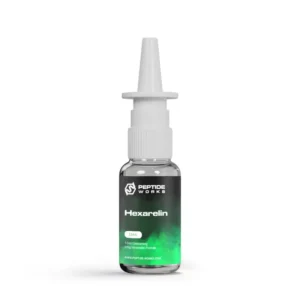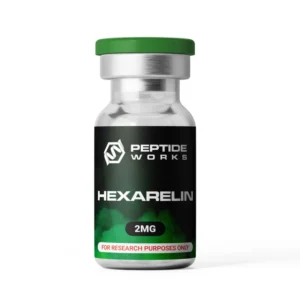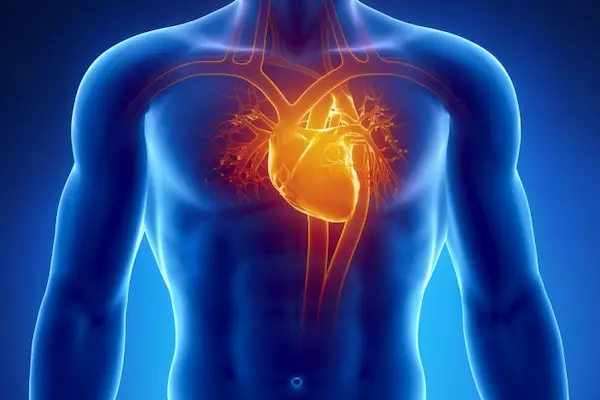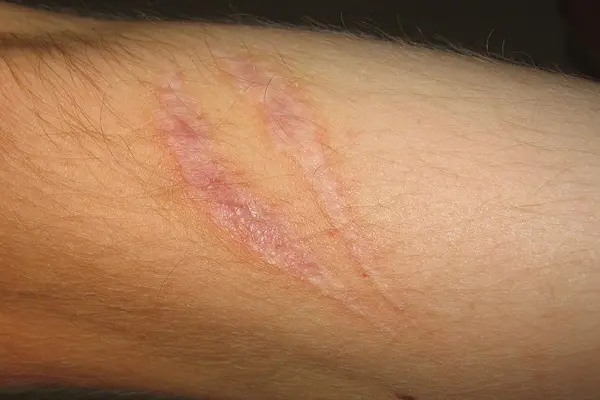PROMO!
First order? Get 10% OFF with this code: 1storder
Our Product Categories



Hexarelin is a synthetic peptide and a growth hormone secretagogue, meaning that it stimulates the release of growth hormone (GH). It is an analogue of the hormone ghrelin and has been studied for its potential benefits in various areas. It promotes growth hormone secretion, supporting muscle growth and metabolism.
Research suggests it may protect the heart, improve glucose and insulin tolerance, lower triglycerides, and aid in reducing atherosclerotic lesions.
Hexarelin is primarily used in research and scientific studies to explore its effects on growth hormone pathways, cardiovascular health, and metabolic functions.
Peptide Sequence (IUPAC Condensed): H-His-D-Trp(2-Me)-Ala-Trp-D-Phe-Lys-NH2
Molecular Formula: 47H58N12O6
Molecular Weight: 887.0 g/mol
Synonyms: Examorelin
View the Hexarelin COA
View the Hexarelin HPLC

Hexarelin increases growth hormone (GH) release by mimicking ghrelin, a natural hormone. It activates the growth hormone secretagogue receptor (GHSR) in the brain, which is the same receptor that ghrelin binds to. Once activated, GHSR signals the pituitary gland to secrete growth hormone into the bloodstream.
The peptide helps boost the body’s natural production of growth hormone when given. It also impacts the HPA axis, which is essential in managing stress and regulating metabolism. By triggering the release of adrenocorticotropic hormone (ACTH), it plays a vital role in how our body responds to stress and maintains balance in various metabolic processes.
This peptide is widely studied for its potential applications in muscle growth, regeneration, cardiovascular health, and metabolic improvements.
Buy Hexarelin Peptide Vial from Peptide Works. This lyophilized peptide is over 99% pure and available in 2mg and 5mg vials or as complete kits supplied with bacteriostatic water and syringes for easy reconstitution.
Stimulates Growth Hormone Release:Research has shown that Hexarelin effectively stimulates GH release by binding to the GHS-R1a receptor in the pituitary and hypothalamus. Studies show Hexarelin induces a rapid and significant GH increase, often surpassing the response to GH-releasing hormone (GHRH). In children, it enhances GH secretion, even in cases of growth delay when primed with testosterone [1].
Studies in aged rats showed that long-term use helped keep growth hormone (GH) levels stable and improved the hypothalamic somatostatin mRNA patterns that regulate GH. This suggests potential benefits for anabolic (muscle-building), regenerative (repair), and metabolic processes. Hexarelin’s potent GH-releasing activity highlights its clinical utility in addressing GH deficiencies and related conditions [2].
Impact on Metabolism, Lipids, and Insulin Sensitivity: Research on Hexarelin has demonstrated significant metabolic benefits in insulin-resistant conditions, as shown in MKR mice. A 12-day treatment improved glucose tolerance, insulin sensitivity, and reduced plasma and liver triglycerides.
It also enhanced body composition by increasing lean mass and reducing fat mass. These effects are linked to improved lipid metabolism via CD36 receptor activation and PPAR-γ gene expression in adipocytes. Hexarelin shows potential for addressing insulin resistance and dyslipidemia in metabolic disorders (animal models) [3].
Bone Strength and Mineral Density: Studies have shown that Hexarelin enhances bone health in middle-aged female rats by increasing bone mineral content (BMC) and bone area. In intact rats, chronic hexarelin treatment (50 µg/kg twice daily for 60 days) improved BMC (+6.5%) and bone area (+4.1%) at lumbar vertebrae. In ovariectomized rats, it increased BMC (+7.2%) and bone area (+5.3%) at femoral mid-diaphyses. These effects suggest hexarelin’s potential to support bone strength via GH/IGF axis stimulation, influenced by estrogen levels [4].
Neuroprotection / Tissue-Protection: Studies suggest Hexarelin shows promising tissue-protective and neuroprotective effects. In a neonatal hypoxia-ischemia rat model, it reduced brain damage by 39%, decreased caspase-3 activity (a cell-death marker), and activated Akt/GSK-3β signaling [5].
In a study on a lung injury and fibrosis mouse model, hexarelin reduced inflammatory cell infiltration, improved lung compliance, and decreased collagen deposition, mitigating fibrosis. These findings suggest hexarelin’s potential in protecting against injury, oxidative stress, and fibrosis in experimental models [6].
Cardioprotective Effects: Research has demonstrated that Hexarelin has significant cardioprotective effects through GH-dependent and independent mechanisms. It improves cardiac output, reduces post-ischemic ventricular dysfunction, and decreases cardiac fibrosis. In human studies, hexarelin acutely increased left ventricular ejection fraction (LVEF) without altering blood pressure or heart rate, suggesting a direct myocardial effect via GHS receptors [7].
Additionally, hexarelin protects cardiomyocytes from angiotensin II-induced apoptosis by reducing caspase-3 activity, increasing Bcl-2 expression, and inhibiting Bax expression [8]. In vascular models, hexarelin mitigates inflammation, smooth muscle cell dysfunction, and elastin degradation, highlighting its potential in conditions like myocardial infarction, heart failure, and aortic aneurysms.
[1] S Loche, P Cambiaso, D Carta, S Setzu, et al (1995) The growth hormone-releasing activity of hexarelin, a new synthetic hexapeptide, in short normal and obese children and in hypopituitary subjects – Journal of Clinical Endocrinology & Metabolism, 1995 Feb, Volume 80 (Issue 2), Pages 674-8.
[2] L Cattaneo, M Luoni, B Settembrini, E E Müller, et al (1997) Effect of long-term administration of Hexarelin on the somatotrophic axis in aged rats – Pharmacological Research, 1997 Jul, Volume 36 (Issue 1), Pages 49-54.
[3] R Mosa, L Huang, Y Wu, C Fung, et al (2017) Hexarelin, a Growth Hormone Secretagogue, Improves Lipid Metabolic Aberrations in Nonobese Insulin-Resistant Male MKR Mice – Endocrinology, Volume 158, Issue 10, 1 October 2017, Pages 3174–3187.
[4] V Sibilia, D Cocchi, I Villa, N Lattuada, et al (2002) Bone effects of hexarelin, a GH-releasing peptide, in female rats: influence of estrogen milieu – European Journal of Endocrinology, 2002 Jun, Volume 146 (Issue 6), Pages 855-62.
[5] K G Brywe, A-L Leverin, M Gustavsson, C Mallard, et al (2005) Growth hormone-releasing peptide hexarelin reduces neonatal brain injury and alters Akt/glycogen synthase kinase-3beta phosphorylation – Endocrinology, 2005 Nov, Volume 146 (Issue 11), Pages 4665-72.
[6] V Zambelli, L Rizzi, P Delvecchio, E Bresciani, et al (2021) Hexarelin modulates lung mechanics, inflammation, and fibrosis in acute lung injury – Drug Target Insights, 2021 Nov 27, Volume 15, Pages 26–33.
[7] G Bisi, V Podio, M R Valetto, F Broglio, et al (1999) Acute cardiovascular and hormonal effects of GH and hexarelin, a synthetic GH-releasing peptide, in humans – Journal of Endocrinological Investigation, 1999 Apr, Volume 22 (Issue 4), Pages 266-72.
[8] J-J Pang, R-K Xu, X-B Xu, J-M Cao, et al (2004) Hexarelin protects rat cardiomyocytes from angiotensin II-induced apoptosis in vitro – American Journal of Physiology. Heart & Circulatory Physiology, 2004 Mar, Volume 286 (Issue 3), Pages H1063-9.
[9] B Jiang, M Wang, X Li, P Ren, et al (2022) Hexarelin attenuates abdominal aortic aneurysm formation by inhibiting SMC phenotype switch and inflammasome activation – Microvascular Research, 2022 Mar, Volume 140, Page 104280.
The answers to the most frequently asked questions about Hexarelin.

Buy Hexarelin Peptide Nasal Spray from Peptide Works. Available in 15ml and 30ml glass spray bottles, this non-invasive administration route provides an easy and effective method for consistent application.
Yes, Hexarelin can be combined with other peptides, such as CJC-1295, to enhance growth hormone release. When stacked together, they may help improve recovery, support muscle growth, and enhance overall performance in studies. This combination also helps researchers better understand how different peptides interact to influence hormone balance and body composition.
Researchers often notice changes from Hexarelin within one to two weeks. It quickly increases growth hormone levels in studies. Physical effects, such as better recovery or improved strength, may take longer to appear. The timing depends on how often it is used and how the test subjects respond during the research.
Hexarelin may cause side effects such as water retention, increased appetite, tiredness, or tingling in the hands and feet. It can also raise levels of cortisol and prolactin in some studies. The effects depend on the amount used and how the body reacts during research testing.
Hexarelin is legal to buy in the United States for research purposes only. It is not approved by the FDA for human use or medical treatment. Licensed laboratories and researchers can purchase it for scientific testing, but it cannot be sold or used as a supplement or medication for human consumption.

This blog takes a closer look at top peptides used for tissue repair, including BPC-157, TB-500, and Hexarelin. It highlights how these compounds may support faster healing, reduce inflammation, and boost collagen production. The discussion also covers their potential roles in repairing muscle, tendon, ligament, and skin tissue, while emphasizing that they are intended for research purposes only. Overall, these peptides show strong potential in advancing the science of tissue regeneration.

This blog explores the potential of the Hexarelin peptide in supporting heart health. It discusses its role in reducing cardiac fibrosis, improving ventricular compliance, and protecting the heart during stress. By examining peptide signaling, the article highlights promising research on Hexarelin and related compounds such as B7-33 and GHRP-6, pointing toward new possibilities in cardiovascular advancement.

Discover the fascinating world of tissue repair peptide therapy in this blog, featuring a special focus on Thymalin. This peptide, known for its role in maintaining immune balance, also supports recovery and regeneration. The article further explores how Thymalin works alongside other peptides such as TB-500, BPC-157, and Hexarelin, each contributing to the science of healing from a unique perspective.
ALL CONTENT AND PRODUCT INFORMATION AVAILABLE ON THIS WEBSITE IS FOR EDUCATIONAL PURPOSES ONLY.
DISCLAIMER: These products are intended solely as a research chemical only. This classification allows for their use only for research development and laboratory studies. The information available on our Peptide Works website: https://peptide-works.com/ is provided for educational purposes only. These products are not for human or animal use or consumption in any manner. Handling of these products should be limited to suitably qualified professionals. They are not to be classified as a drug, food, cosmetic, or medicinal product and must not be mislabelled or used as such.